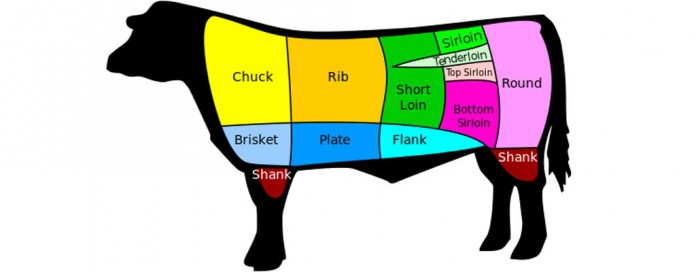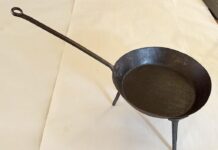When you look around the beef section of the grocery store, you might be overwhelmed at the sight of so many different cuts. Maybe you’ve always purchased the same cuts and want to try something different, but don’t know what to choose.
Let’s start with the basics: There are four major, or primal, cuts of beef, according to the USDA: chuck, loin, rib and round. These cuts are divided into subprimal cuts and then finally into retail cuts, which you find in the grocery store.
There are specific characteristics, uses and recommended cooking methods for each cut. We’re going to look at the basic cuts: ground beef, steaks, oven and pot roasts and prepared cuts like kabobs, stew meat and stir-fry meat.
Ground beef
Ground beef is beef that’s cut into small pieces with a meat grinder. It’s taken from several cuts, like the chuck, rib and flank. Sometimes ground beef is taken from the plate, but it’s fatty. Ground beef varies in lean-to-fat ratios; it’s no more than 30 percent fat and is always at least 70 percent lean.
Ground beef that’s 70 percent lean is great for burgers, taco meat and spaghetti sauce because it’s moist and juicy. Ground beef that’s 80-85 percent lean is best used for meatloaf and meatballs because even though it’s slightly firm, it’s still moist and juicy. 93 percent lean beef doesn’t have as much fat to drain, so it works well for meat sauces, casseroles and stuffed peppers.
Cooking methods: grilling (dry heat), broiling (moist heat)
Steaks
A steak is a cut of meat typically taken from the rear of the cow.
A lot of tender steaks come from center cuts (the rib and the loin). The center of the cow is used for suspension and doesn’t get much movement, so the meat that’s taken from there is generally tender. The two types of tender steaks are premium tender steaks and family-priced tender steaks.
Premium tender steaks include top loin, T-Bone, Porterhouse, rib-eye, rib and tenderloin.
Family-priced tender steaks, such as top sirloin, chuck top blade, chuck eye and round tip, are more affordable.
Cooking method: Dry heat cooking methods, like roasting, grilling, broiling or skillet cooking.
Less tender steaks come from the front (the chuck) and rear (the round) of the cow. These parts are used for movement, so the meat is much tougher than the center of the cow. Some less tender steaks include full-cut round, top round, eye round and bottom round
Cooking method: These cuts can be prepared with moist heat since they aren’t as tender as center cuts.
Cubed steak is another type of steak. This cut normally come from the round, so it’s more on the tough side.
Cooking method: Moist heat or skillet cooking (dry heat)
Some steaks are considered lean, while others are not. For more information, see Beef, It’s What’s For Dinner’s Interactive Butcher Counter.
Roasts and Ribs
A roast is a two-inch or thicker cut of beef. Beef roasts come from several different cuts, usually in fore- and hindquarters of the cow, although some come from center cuts.
Oven roasts are classified as premium oven roasts or family-priced oven roasts.
Premium oven roasts include cuts like rib, rib-eye and tenderloin. They’re more expensive than family-priced oven roasts.
Family-priced oven roasts are more affordable, plus they’re leaner than premium oven roasts. Some popular family-priced oven roasts are tri-tip, round tip, rump, bottom round and eye round.
Cooking method: On an oven rack in a shallow pan or in a covered grill (dry heat)
Pot roasts come from the fore- and hindquarters, so they’re less tender than oven roasts. Pot roasts from the chuck are more flavorful because they contain more fat than the round. Meat from the brisket are used for pot roast, too.
Cuts from the chuck that are great for pot roast include bone-in and boneless chuck arm pot roast, bone-in and boneless chuck blade pot roast, chuck 7-Blade pot roast and boneless chuck shoulder pot roast. Bone-in and boneless chuck cross rib pot roast, boneless chuck mock tender roast, boneless chuck top blade roast and boneless chuck eye roast can also be used for pot roast, but they’re not as common.
Cuts from the round that can be used for pot roast include round rump roast, bottom round roast, eye round roast and round tip roast.
Brisket cuts are boneless and are sold either fresh or corned. Brisket cuts include whole brisket, point half/point cut, flat half/flat cut and middle cut.
Beef chuck (chuck blade, arm or shoulder roast) and round cuts (boneless rump roast, bottom round roast) work well for pot roasts.
Cooking method: Preparing a pot roast means you’re using moist heat. It may take longer, but the results will be tender, juicy meat.
Other cuts
Beef for kabobs is usually from the sirloin or the round, but it can be taken from any cut other than the shank. It’s cut into 1 to 1.5 inch thick pieces. Kabob meat from the round will need to be tenderized. Meat from a more tender cut won’t need to be tenderized.
Cooking method: Grilling or broiling (dry heat)
Stew meat is taken from any cut except the shank, but it usually comes from the chuck or the round. Stew meat is boneless and cut into ¾ or ½ inch cubed pieces.
Cooking method: Braising or pot roasting (moist heat)
Stir-fry, or strips, are cuts taken from tender beef cuts like sirloin, top sirloin, tri-tip, rib-eye, top loin or tenderloin. Flank, top round and round tip steaks aren’t very tender, but they can work for stir-fry meat, too.
Cooking method: Stir-frying (dry heat)
The shank is the leg of the animal. It’s juicy but tough, so it’s normally used as stock for soups and stews.
Cooking method: Braising (moist heat)
Sources: USDA Food Safety and Inspection Service, Iowa Beef Industry Council, Cattlemen’s Beef Board, Certified Angus Beef, Beef, It’s What’s for Dinner


















Wonderful info, thanks! Here’s a great chart with information about each cut. Recipes for each cooking method, too: http://www.certifiedangusbeef.com/cuts/
Hi Jennifer,
Thanks for sharing that link!
I never knew that rib-eye steaks are very tender steaks that have marbling. My wife and I are going to a steakhouse for our anniversary soon. Hopefully, we can use this info to order the best steak for our special occasion.